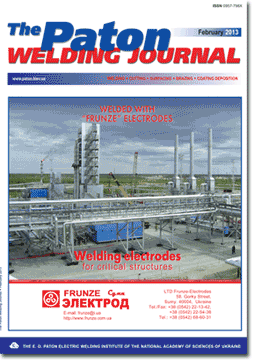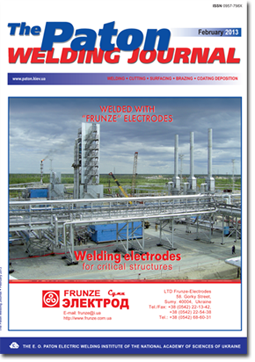| 2013 №02 (04) | 2013 №02 (06) |

The Paton Welding Journal, 2013, #2, 24-30 pages
INVESTIGATION OF DISPERSION OF DISSIMILAR WIRE MATERIALS DURING ELECTRIC ARC SPRAYING
Yu.S. BORISOV, N.V. VIGILYANSKAYA, I.A. DEMIANOV, A.P. GRISHCHENKO and A.P. MURASHOV
E.O. Paton Electric Welding Institute, NASU, Kiev, Ukraine
Abstract
The process of combined spraying of steel and copper wires under the electric arc spraying conditions was investigated. The effect of spraying parameters on the process of spraying of dissimilar wires was established, this making it possible to control particle size distribution of the spraying products in electric arc spraying of pseudo-alloy coatings and, hence, structure and properties of the resulting coatings. 2 mm diameter wires, i.e. copper wire of the M1 grade and steel wire Sv-08A, were used as spraying consumables. Investigations were carried out by using electric arc metalliser EM-14M. The regression equations describing dependence of the mean size of particles on the electric power, compressed air pressure and spraying distance were derived by using mathematical experimental design. It was found that the mean size of particles depends primarily on the compressed air pressure. Combining the maximal values of the power (9.6 kW) and compressed air pressure (7 atm) during spraying results in formation of particles of the minimal size: 37 mm in spraying of copper wire, 54 mm in spraying of steel wire Sv-08A, and 52 mm in their combined spraying. Combining the minimal values of the power (1.7 kW) and compressed air pressure (6 atm) leads to formation of particles of the maximal size: 54 mm in spraying of copper wire, 85 mm in spraying of steel wire Sv-08A, and 85 mm in their combined spraying. It was found that the pseudo-alloy particles consisting of particles of the steel melt with a copper shell on their surface are formed during the process of combined spraying of copper and steel wires as a result of inter-phase interaction of their melts. 24 Ref., 1 Table, 6 Figures.
Keywords: electric arc spraying, steel and copper wire, melt dispersion, inter-phase interaction, pseudo-alloy, particle size distribution, microstructure of particles
Received: 26.11.12
Published: 28.02.13
References
1. Baldaev, L.Kh., Borisov, V.N., Vakhalin, V.A. (2007) Thermal spraying: Manual. Ed. by L.Kh. Baldaev. Moscow: Market DS.
2. Kudinov, V.V., Bobrov, G.V. (1992) Spraying of coatings: theory, technology and equipment: Manual. Ed. by B.S. Mitin. Moscow: Metallurgiya.
3. Borisov, Yu.S., Korzhik, V.N. (1995) Amorphous thermal coatings. Theory and practice (Review). Avtomatich. Svarka, 4, 3-11.
4. Vakhalin, V.A., Kudinov, V.V., Belashchenko, V.E. (1981) Investigation of effective efficiency of heating of electrodes and material utilisation factor in arc metallising. Fizika i Khimiya Obrab. Materialov, 8, 65-69.
5. Kats, N.V., Antoshin, E.V., Vadivasov, D.G. (1966) Spray metallising. Moscow: Mashinostroenie.
6. Troitsky, A.F. (1960) Principles of metallising by spraying. Tashkent: Gosizdat UzSSR.
7. Royanov, V.A. (1990) Melting of electrodes in arc metallising. Svarochn. Proizvodstvo, 2, 35-38.
8. Ageev, V.A., Belashchenko, V.E., Feldman, I.E. et al. (1989) Analysis of methods for control of parameters of spraying particles in electric arc metallising. Ibid., 12, 30-32.
9. Korobov, Yu.S. (2004) Estimation of forces affecting the spray metal in electric arc metallising. The Paton Welding J., 7, 21-25.
10. Vakhalin, V.A., Kudinov, V.V., Maslennikov, S.B. et al. (1981) Process of melting and spraying of electrode material in electric arc metallising. Fizika i Khimiya Obrab. Materialov, 3, 58-63.
11. Korobov, Yu.S., Boronenkov, V.N. (1998) Calculation of parameters of motion, heating and oxidation of particles in electric arc metallising. Svarochn. Proizvodstvo, 3, 9-13.
12. Kuznetsov, V.D., Pashchenko, V.M. (1999) Physical-chemical principles of coating formation: Manual. Kyiv: NMTs VO.
13. Boronenkov, V.N., Korobov, Yu.S. (2012) Fundamentals of arc metallising. Physical-chemical principles. Ekaterinburg: UralGU.
14. Newbery, A.P., Granta, P.S., Neiser, R.A. (2005) The velocity and temperature of steel droplets during electric arc spraying. Surface and Coatings Technology, 195(1), 91-101.
15. Planch, M.P., Liao, H., Coddet, C. (2004) Relationships between inflight particle characteristics and coating microstructure with a twin wire arc spray process and different working conditions. Ibid., 182 (2/3), 215-226.
16. Novik, F.S., Arsov, Ya.B. (1980) Optimisation of metal technology process by experimental design methods. Moscow: Mashinostroenie.
17. Kats, N.V., Antoshin, E.V., Vadivasov, D.G. et al. (1966) Spray metallising. Moscow: Mashinostroenie.
18. Shashkov, A.N. (1960) Antifriction pseudo-alloys. Moscow: Mashgiz.
19. Krasnichenko, L.V., Smolyaninov, A.I., Podkovich, E.G. et al. (1966) Complex metallising pseudo-alloys as bearing materials. In: Application of new materials in agricultural machine-building: Transact. Rostov-na-Donu: Risknm, 3-20.
20. (1985) Properties of elements: Refer. Book. Ed. by M.E. Dritsa. Moscow: Metallurgiya.
21. Hansen, M., Anderko, K. (1962) Structures of binary alloys. Vol.2. Moscow: Metallurgizdat.
22. Detlaf, A.A., Yavorsky, B.M. (1973) Course of physics. Mechanics. Fundamentals of molecular physics and thermodynamics: Manual. Vol. 1. Moscow: Vysshaya Shkola.
23. Borisov, Yu.S. (1982) Theoretical and technological principles of deposition of plasma coatings from composite powders: Syn. of Thesis for Dr. of Techn. Sci. Degree. Kiev.
24. Formation of sprayed layer. http://www.hvof.org-/theory/forming
Suggested Citation
Yu.S. BORISOV, N.V. VIGILYANSKAYA, I.A. DEMIANOV, A.P. GRISHCHENKO and A.P. MURASHOV (2013) INVESTIGATION OF DISPERSION OF DISSIMILAR WIRE MATERIALS DURING ELECTRIC ARC SPRAYING. The Paton Welding J., 02, 24-30.The cost of subscription/purchase order journals or individual articles
| Journal/Currency | Annual Set | 1 issue printed |
1 issue |
one article |
| TPWJ/USD | 384 $ | 32 $ | 26 $ | 13 $ |
| TPWJ/EUR | 348 € | 29 € | 24 € | 12 € |
| TPWJ/UAH | 7200 UAH | 600 UAH | 600 UAH | 280 UAH |
| AS/UAH | 1800 UAH | 300 UAH | 300 UAH | 150 UAH |
| AS/USD | 192 $ | 32 $ | 26 $ | 13 $ |
| AS/EUR | 180 € | 30 € | 25 € | 12 € |
| SEM/UAH | 1200 UAH | 300 UAH | 300 UAH | 150 UAH |
| SEM/USD | 128 $ | 32 $ | 26 $ | 13 $ |
| SEM/EUR | 120 € | 30 € | 25 € | 12 € |
| TDNK/UAH | 1200 UAH | 300 UAH | 300 UAH | 150 UAH |
| TDNK/USD | 128 $ | 32 $ | 26 $ | 13 $ |
| TDNK/EUR | 120 € | 30 € | 25 € | 15 € |
AS = «Automatic Welding» - 6 issues per year;
TPWJ = «PATON WELDING JOURNAL» - 12 issues per year;
SEM = «Electrometallurgy Today» - 4 issues per year;
TDNK = «Technical Diagnostics and Non-Destructive Testing» - 4 issues per year.


